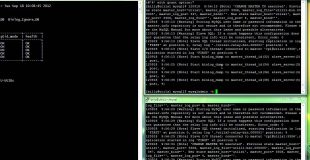MySQL Replication Utilities Tutorial. Learn how to use MySQL 5.6 and the MySQL Utilities to setup, monitor and manage your MySQL replication topology.
Original source
MySQL 5.6 Replication Utilities Tutorial


MySQL Replication Utilities Tutorial. Learn how to use MySQL 5.6 and the MySQL Utilities to setup, monitor and manage your MySQL replication topology.
Original source
6 responses to “MySQL 5.6 Replication Utilities Tutorial”
What about the config file parameters that need to be setup before the replication can begin?
how to get(open) "bill@utils1:~mysql" and "bill@utils2:~mysql"
please help.
Nice one
I liked it but though it oversimplified some things. For example the instructor used the root user a lot which in practical practice is a huge security no no.
Also the example did not explain how different configurations or states of the slaves would be effected. For example can I assume as I have that this tool replicates every database and every table or replicable Storage Engines ?
What would happen if I was missing any tables in each of the databases would that effectively copy over just the updates and inserts from the time replication begins or would it synchronize each and all tables??
For example if I were replicating a single database innoworld and I only had City table in my slaves and all tables in my master what would happen? Would those first checks have failed or would the tables be copied to sync up the tables?
My first thought is no syncing up of tables I must have all the tables defined and only transactions starting when the slaves are started are handled.
Still it would be good to understand how the failover utility works internally which it presumably does by keeping track of all the information you shared in those preceding commands. Still those file position issues appear to be handled – where are they handled in the actual mysqlreplicate command?
Is that where the master.info information is essentially handled?
and the CHANGE TO MASTER commands automatically created and executed in each slave using the original master?
I think this demo is really confusing with the same names for each server and different ports.
Great demo, thanks Andrew